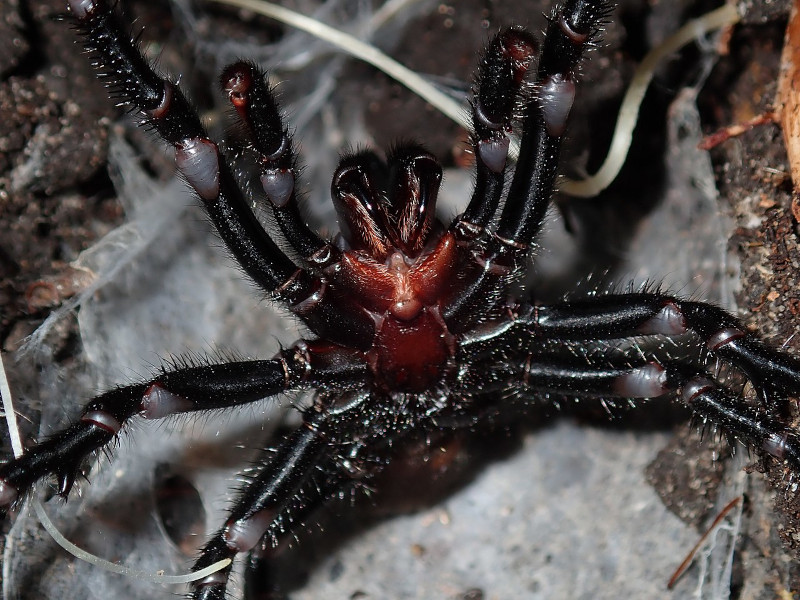
Sydney Funnel-web Spider Facts
- This imposing creation of Nature and evolution most frequently goes by the informative common name of the Sydney Funnel-web Spider. For the moment, this arachnid has no other broadly accepted general title. It doesn’t really need one, though.
- Inside of scientific circles, however, the creature is perhaps better known by its technical designation. Fortunately for the layperson, though, that’s a comparatively simple term to pronounce. That’s because it holds the formal epithet of Atrax robustus.
- The invertebrate received that moniker due to the efforts of Octavius Pickard-Cambridge. The noted British zoologist recorded the first acknowledgement of it as a separate and distinct species. He achieved that scientifically noteworthy deed in 1877.
- The impressive Sydney Funnel-web Spider appears to be maintaining a population base that’s both stable and sufficient. That trend also seems to hold true throughout its known range. The IUCN therefore presently has no listing for in on its Red List.
- The creature nonetheless should be considered as facing at least several potential threats to its continued existence as a species. Like most forms of life on the planet, most of these stem from the actions of man. They include the effects of climate change.
Related Articles
Sydney Funnel-web Spider Physical Description
The eye-catching Sydney Funnel-web Spider generally draws a great deal of attention from those who encounter the arachnid. It does so more due to its nature and appearance than its size, though. That’s because in that respect it’s about an average-sized example.
It follows a pattern of development shared by most of its kindred around the globe. That’s in the fact that it displays a certain degree of the physiological characteristic of sexual dimorphism. In its specific case, this trait manifests itself purely in terms of physical size.
More specifically, the females attain a greater overall average size than their male counterparts. This difference in measurement sometimes reaches significant degrees. Larger females of the species occasionally grow to 3 -4 times the size of their male counterparts.
Body lengths therefore range from approximately 0.4 – 2.0 in (1 – 5cm). The legspan, however, adds significantly to this, for both sexes. That’s due to the fact that, combining measurements for both genders, their legs average 2.4 – 2.8 in (6 – 7 cm) in length.
In terms of coloring, though, both genders of the Sydney Funnel-web Spider present the same basic patterns. Colors vary, but range from a glossy blue-black, to black, brown, or even a dark plum shade. Precise combinations and patterns vary among individuals.
The carapace evolved as nearly hairless, and displays seeming smooth, glossy texture. Its eight segmented legs also possess a thin covering of dark hair. Spinnerets, resembling small fingers, also appear at the end of the abdomen. Males have a large mating spur females lack.
- Kingdom: Animali
- Phylum: Arthropoda
- Class: Arachnida
- Order: Araneae
- Family: Atracidae
- Genus: Atrax
- Species: A. robustus
Sydney Funnel-web Spider Distribution, Habitat, and Ecology
Nature evolved the amazing Sydney Funnel-web Spider as endemic to a very small section of the earth’s surface. The placement of that zone of habitation doesn’t surprise anyone who learns of it, though. That’s due to the simple fact that its very name implies the region.
The Arthropod developed as endemic to the continent of Australia. Yet, even there it only inhabits a very limited portion of the greater overall area. As its tag implies, that’s centered around Sydney. It also extends to the Blue Mountains and the Central Coast.
Fortunately for it, evolution provided the animal with a moderately impressive flexibility regarding its choice of habitat. It thus appears in a range of ecosystems. These principally consist of regions of either wet rainforests or areas adapted to long dry, hot periods.
The spider further usually prefers to make its home in locations that remain humid and cooler. These often include such diverse spots as under leaves and fallen trees. However, to the dismay of local residents, its not afraid to take up residence in private gardens.
Due to its nature, the Sydney Funnel-web Spider generally constructs silk-lined underground burrows. These tunnels also typically possess hidden trapdoors or collapsible entrances. It’s from these that it lunges out to attack the prey that triggers hidden trip lines.
Like most of its relatives, it also feeds exclusively as a carnivore. The majority if its nutrition comes from a wide range of local insect species. However, it also sometimes dines on small arthropods, like millipedes or snails. It even sometimes catches smaller types of frogs!
Species Sharing Its Range
Check out our other articles on 4 Gorgeous European Gorges, Striped Skunk, Mount Vesuvius, Texas Blind Salamander, Mountain Laurel, Spiny Butterfly Ray, California Mantis, Philippine sailfin lizard
